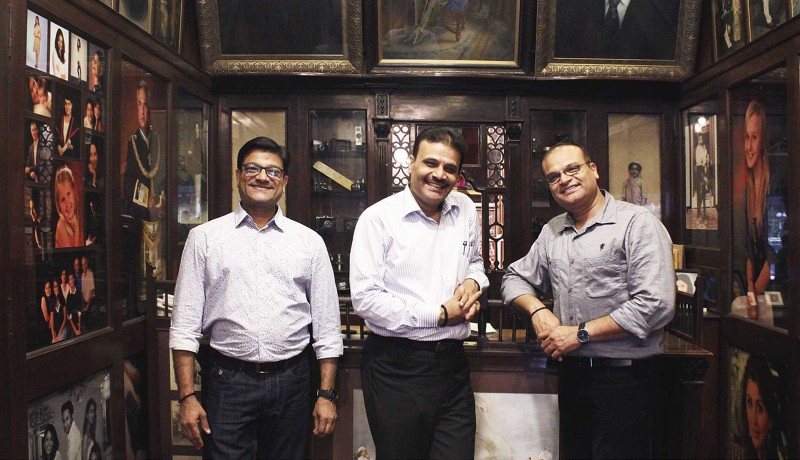
Etcetera

Indian Art Studio, one of Mumbai’s beloved icons, has been freezing memories for over a hundred years, writes Anisha Samuel
In the basement of an old building in Kalbadevi, Mumbai, the proprietors of what is arguably the city’s oldest photo studio rummage through decades of photographic treasures saved by their father and grandfather, from whom they learnt the art of photography. In the early 1900s, there were only five to six studios in the locality, and Indian Art Studio was one of them.
Among this collection are pictures of India’s first prime minister Jawaharlal Nehru in various moods, and his successor Lal Bahadur Shastri. The collection also has pictures of Bollywood superstars Dilip Kumar and Raj Kapoor, and a few negatives of Shashi Kapoor playing cricket, shot by earlier generations of the family.
These treasures exist thanks to Hargopal Singh Chaddha, a self-taught photographer and founder of Indian Art Studio, who was also vice-president of the Professional Photographers Association. “Our grandfather’s contacts helped him build an impressive clientele, which included royalty like the Maharaja of Morbi Estate in Gujarat and even former prime minister Indira Gandhi,” says Anil Singh Chaddha, the eldest of the three brothers who run the studio today.
Hargopal’s son Yaggopal Singh Chaddha took over the studio in the 1960s and turned it into the official photographer for industrialists and political events. “Why, even Kodak wanted to lease the property to open a photo processing lab here but my father wouldn’t hear of it! During this time, transforming studios into film processing labs was all the rage but our dad had done the math. He didn’t fancy investing in equipment that develops photographs and toiling over heaps of negatives just to break even,” says Anil’s brother Sanjay.
The brothers entered the profession in the 1990s. And to counter the changes wrought by technology, they offer services like product photography, wedding photography, industrial photography, videography, and much more. But here’s what sets this studio apart: the Chaddhas still take portraits using the same props used in the days of yore, and undertake hand-tinting to restore old photographs.
The third brother Rajesh says that during his grandfather’s time, the studio was a pioneer in photography because it had a range of sizes in plate cameras, to take group photos as well as smaller passport-size photos. “Back then, a wedding needed to be shot in 20-24 pictures because each click meant that another magnesium flash bulb would burst,” he explains.
“Taking photos was an activity for festivals and special events,” he adds. “Folks would line up in their Sunday best outside the studio and wait their turn to get portraits taken. They would stand still for maybe five minutes after the flash went off so that the image came off sharp and they could have that one cherished photo of their loved ones.”
Anil points out that any imperfections in a negative were worked on with the ‘Photoshop’ tools of the time: a spotting pencil and dyes that cleaned them up. “After all this work, three copies of a portrait would bring in about 80, while three copies of a passport-size photo fetched 20. This is the equivalent of around 2,500 today.”
Indian Art Studio was ahead of its time in many ways. “In the 1970s, there were two huge boards outside the studio, announcing ‘Passport Photos In Half An Hour’,” recalls Sanjay. “That’s because we used single-cut films. Otherwise, one would have to wait for 12 customers to finish the strip before it was developed.”
When the three brothers entered the profession, it was an uncertain time for photo studios. “Compact cameras were already in the market but we stayed focused. We made sure we remained a part of photographic associations, which got us assignments shooting prestigious people. Earlier, we also did a lot of press work and journalism photography,” reveals Rajesh.
Continuing the tradition at Indian Art Studio is not the preserve of the owners alone. Sometimes, customers play a vital role. “My grandfather Hargopal had the privilege of shooting the Morbi Estate in Gujarat, during the time of Maharaja Mahendra Singh. Years later, I was called to shoot the Maharaja’s grandson’s wedding in Morbi,” Rajesh tells us.
When he went to Morbi Estate in Rajkot, the Maharaja’s wife showed him the pictures that his grandfather had taken. “It was a proud moment for the Maharaja’s grandson and me because my grandfather had served his grandfather. Now the third generation was back doing the same thing.”
Pulling out another cherished moment, Sanjay adds, “Our father was a perfectionist and he had no qualms about stopping a group photo-shoot to tell Giani Zail Singh that his sherwani needed to be adjusted. He was later thanked by the former President for being true to his profession!”
In their leisure time, the Chaddhas descend into the studio’s basement and, under the original tungsten bulbs and old, wooden furniture, they sort through piles of photographs clicked over the decades. There’s even a chair with a ‘hidden table’ that was used by their father’s accountant. Their mission: to create an archiving project that will showcase the history of the studio along with the now famous personalities who once posed for their photos.
Photos: Natasha Rego Featured in Harmony — Celebrate Age Magazine October 2018
you may also like to read
-
Cracking the longevity code
Small yet impactful choices can be game-changers, writes Srirekha Pillai At 102, there’s no stopping Chandigarh-based Man Kaur, the world’s….
-
Home, not alone
While a regulatory framework is vital for senior-care facilities, the need of the hour is to develop an ecosystem to….
-
Birthday Girl
Published in a special edition to honour Japanese master storyteller Haruki Murakami’s 70th birthday, Birthday Girl (Penguin; Rs 100; 42….
-
A huge treat for music lovers
Published as the revised and updated second edition, Incomparable Sachin Dev Burman (Blue Pencil; Rs. 599; 470 pages) the authoritative….







